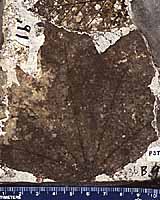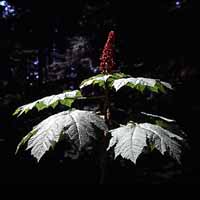







The asterids first appear in the Maastrichtian (Cretaceous). Fossils recognizable as belonging to the basal (primitive) groups Aquifoliaceae (hollies) and Apiales (carrot group). Thus, not only did the group exist, but it had begun to diversify by this time.
Most other asterid groups do not appear in the fossil record before the Eocene, leaving a gap of nearly 16 million years between the time asterids first appear and most groups are recorded. It is possible that this is the result of an evolutionary radiation, since four major groups of asterids appear at about this time. It is also possible that the discovery of additional fossils will change this picture.
 |
 |
Fossil asterids : On the left, a fossil of Kalopanax acerifoilum from the Miocene of Shandong, China. On the right, the living species Oplopanax horridum from Mt. Rainier in Washington state, USA. Compare the large leaves of these two species (click on either picture for a larger image).
The Garryaceae has usually been classified with the Cornaceae (dogwoods). Molecular evidence suggests that the Garryaceae may actually be closely related to the Lamiidae, but no formal change in its classification has yet been made. Fossils of the Garryaceae also show up in the Eocene, at the same time as most asterid groups, and much later than the cornids.

The image of Oplopanax is the property of the Jepson Herbarium.

